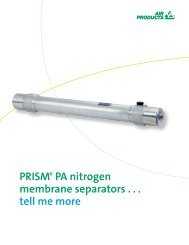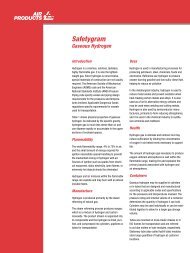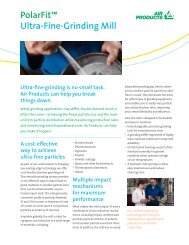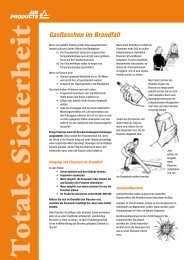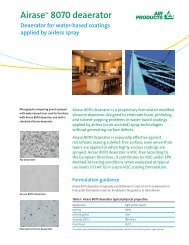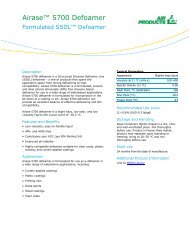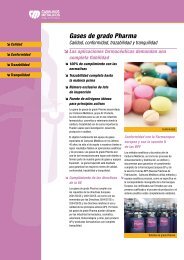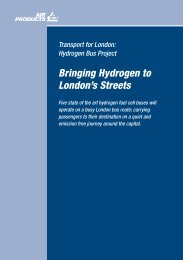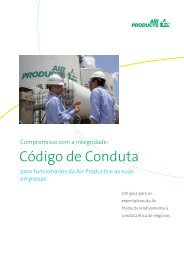Nitrogen - Product Stewardship Summary - Air Products and ...
Nitrogen - Product Stewardship Summary - Air Products and ...
Nitrogen - Product Stewardship Summary - Air Products and ...
Create successful ePaper yourself
Turn your PDF publications into a flip-book with our unique Google optimized e-Paper software.
Physical <strong>and</strong> Chemical Properties<br />
<strong>Nitrogen</strong> has no color or smell. It does not burn.<br />
It’s slightly lighter than air <strong>and</strong> slightly water<br />
soluble. <strong>Nitrogen</strong> is inert, which means that it<br />
does not react with many materials. However, it<br />
can form compounds under certain conditions.<br />
For example, at high temperatures, nitrogen<br />
reacts with oxygen to form various oxides of<br />
Health Effects<br />
The air we breathe is 78 percent nitrogen. The<br />
balance is primarily oxygen, at roughly 21 percent.<br />
Oxygen is the only element in the air that<br />
supports life. Our body doesn’t use the nitrogen<br />
we breathe. We exhale about the same amount<br />
of nitrogen as we inhale.<br />
Higher levels of nitrogen or other gases in the<br />
air lower the amount of oxygen available to<br />
Environmental Effects<br />
We can manufacture <strong>and</strong> use nitrogen safely<br />
without harming the environment. In a way, we<br />
are only “borrowing” the nitrogen from the air.<br />
Most industrial applications can simply return<br />
Exposure Potential <strong>and</strong> Risk Management Measures<br />
Industrial Use<br />
We ship nitrogen as a high-pressure gas or a<br />
cold liquid. We often ship <strong>and</strong> store gases in<br />
liquid form, because they occupy much less<br />
space that way.<br />
We store <strong>and</strong> ship nitrogen gas in two different<br />
container sizes. Depending on how much<br />
our customer uses, we provide the gas in<br />
high-pressure cylinders <strong>and</strong> tubes. Industry<br />
guidelines cover the storage <strong>and</strong> h<strong>and</strong>ling of<br />
compressed gas cylinders. Workers should use<br />
sturdy work gloves, safety glasses with side<br />
shields <strong>and</strong> safety shoes when h<strong>and</strong>ling compressed<br />
gas cylinders.<br />
nitrogen. It can also form other compounds in<br />
the presence of catalysts.<br />
When cooled to extremely low temperatures<br />
(-321°F/-196°C), nitrogen exists in liquid form.<br />
To put that temperature into perspective, water<br />
freezes at 32°F/0°C.<br />
breathe. This can lead to dizziness, nausea,<br />
vomiting, loss of consciousness <strong>and</strong> death.<br />
No one should enter an area with less than<br />
19.5 percent oxygen without special breathing<br />
equipment to prevent suffocation.<br />
Liquid nitrogen is so cold that it can burn your<br />
skin, just like when a doctor uses it to remove a<br />
mole or a wart from your skin.<br />
the nitrogen to the air when they are finished<br />
using it. Plants <strong>and</strong> animals use nitrogen<br />
from the environment, <strong>and</strong> then they return<br />
it to the atmosphere. This nitrogen cycle is a<br />
critical process for life.<br />
We also store <strong>and</strong> ship liquid nitrogen in three<br />
different types of containers—dewars, cryogenic<br />
liquid cylinders <strong>and</strong> cryogenic liquid<br />
tanks. These containers are similar to heavy-<br />
duty vacuum bottles used to keep your coffee<br />
hot or your water cold. Because of its low<br />
temperature, liquid nitrogen should not come in<br />
contact with skin. For workers who h<strong>and</strong>le containers<br />
of liquid nitrogen, it is important to wear<br />
a full face-shield to protect the eyes <strong>and</strong> face.<br />
Workers should also wear clean, loose-fitting,<br />
thermal-insulated gloves; a long-sleeved shirt<br />
<strong>and</strong> pants without cuffs; <strong>and</strong> safety shoes.



